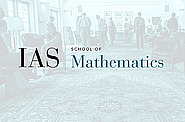Seminars Sorted by Series
Computer Science/Discrete Mathematics Seminar II
Nov
10
2009
Computer Science/Discrete Mathematics Seminar II
Graph and Subgraph Sparsification and its Implications to Linear System Solving and Transforming Graphs into Expanders
10:30am|S-101
Nov
17
2009
Computer Science/Discrete Mathematics Seminar II
No Seminar -- Oberwolfach Meeting on Complexity Theory
10:30am
Nov
24
2009
Computer Science/Discrete Mathematics Seminar II
Arithmetic Progressions in Primes
Madhur Tulsiani
10:30am|S-101
Dec
01
2009
Computer Science/Discrete Mathematics Seminar II
Algorithmic Dense Model Theorems, Decompositions, and Regularity Theorems
10:30am|S-101
Dec
08
2009
Computer Science/Discrete Mathematics Seminar II
Algorithmic Dense Model Theorems, Decompositions, and Regularity Theorems
10:30am|S-101
Dec
15
2009
Computer Science/Discrete Mathematics Seminar II
An Algorithmic Proof of Forster's Lower Bound
Moritz Hardt
10:30am|S-101
Dec
22
2009
Computer Science/Discrete Mathematics Seminar II
The talks will resume during the School of Mathematics Second Term.
10:30am
Jan
19
2010
Computer Science/Discrete Mathematics Seminar II
Limits of Randomly Grown Graph Sequences
10:30am|S-101
Jan
26
2010
Computer Science/Discrete Mathematics Seminar II
Representation Theory and Expansion in Groups
10:30am|S-101
Feb
02
2010
Computer Science/Discrete Mathematics Seminar II
Representation Theory and Expansion in Groups
10:30am|S-101
Feb
09
2010
Computer Science/Discrete Mathematics Seminar II
Representation Theory and Expansion in Groups
10:30am|S-101
Feb
16
2010
Computer Science/Discrete Mathematics Seminar II
Complexity of Constraint Satisfaction problems: Exact and Approximate
Prasad Raghavendra
10:30am|S-101
Feb
23
2010
Computer Science/Discrete Mathematics Seminar II
Testing Correlations and Inverse Theorems
10:30am|S-101
Mar
02
2010
Computer Science/Discrete Mathematics Seminar II
Computational Complexity and Information Asymmetry in Financial Products
10:30am|S-101
Mar
09
2010
Computer Science/Discrete Mathematics Seminar II
Algorithms vs. Hardness
Nisheeth Vishnoi
10:30am|S-101
Mar
16
2010
Computer Science/Discrete Mathematics Seminar II
Pseudorandom Generators for Regular Branching Programs
10:30am|West Bldg. Lecture Hall
Mar
23
2010
Computer Science/Discrete Mathematics Seminar II
No talk today in lieu of the U.S. Income Tax Seminar for Members
10:30am|S-101
Mar
30
2010
Computer Science/Discrete Mathematics Seminar II
A Combinatorial Proof of the Chernoff-Hoeffding Bound, With Applications to Direct-Product Theorems
10:30am|S-101
Apr
06
2010
Apr
13
2010
Computer Science/Discrete Mathematics Seminar II
Critical Slowdown for the Ising Model on the Two-Dimensional Lattice
Eyal Lubetzky
10:30am|S-101
Apr
20
2010
Apr
27
2010
Computer Science/Discrete Mathematics Seminar II
Hardness of Approximately Solving Linear Equations Over Reals
10:30am|S-101
May
04
2010
Computer Science/Discrete Mathematics Seminar II
Explicit Construction of RIP Matrices, Matrices With Small Coherence, and Related Problems
10:30am|S-101
May
11
2010
May
18
2010
Computer Science/Discrete Mathematics Seminar II
Reductions Between Expansion Problems
10:30am|West Bldg. Lecture Hall
May
25
2010
Sep
21
2010
Computer Science/Discrete Mathematics Seminar II
Invariance Principles in Theoretical Computer Science
10:30am|S-101
Sep
28
2010
Computer Science/Discrete Mathematics Seminar II
High-Rate Codes with Sublinear Time Decoding
10:30am|S-101
Oct
05
2010
Computer Science/Discrete Mathematics Seminar II
Pseudorandom Generators for CCO[p] and the Fourier Spectrum of Low-Degree Polynomials Over Finite Fields
10:30am|S-101
Oct
12
2010
Computer Science/Discrete Mathematics Seminar II
Approximating the Longest Increasing Subsequence in Polylogarithmic Time
10:30am|S-101
Oct
19
2010
Computer Science/Discrete Mathematics Seminar II
Rank Bounds for Design Matrices with Applications to Combinatorial Geometry and Locally Correctable Codes
10:30am|S-101
Oct
26
2010
Nov
02
2010
Computer Science/Discrete Mathematics Seminar II
Fourier Spectrum of Polynomials Over Finite Fields
10:30am|S-101
Nov
02
2010
Computer Science/Discrete Mathematics Seminar II
3/2 Firefighters Are Not Enough
Rani Hod
11:30am|S-101
Nov
09
2010
Computer Science/Discrete Mathematics Seminar II
An Elementary Proof of the Restricted Invertibility Theorem
10:30am|S-101
Nov
16
2010
Computer Science/Discrete Mathematics Seminar II
Planar Convexity, Infinite Perfect Graphs and Lipschitz Continuity
10:30am|S-101
Nov
23
2010
Computer Science/Discrete Mathematics Seminar II
Counting Pattern Avoiding Permutations Via Integral Operators
10:30am|S-101
Nov
30
2010
Computer Science/Discrete Mathematics Seminar II
Hardness Escalation and the Rank of Polynomial Threshold Proofs
10:30am|S-101
Dec
14
2010
Computer Science/Discrete Mathematics Seminar II
Erdos Distinct distance Problem in the Plane
10:30am|S-101
Jan
18
2011
Computer Science/Discrete Mathematics Seminar II
Efficiently Learning Mixtures of Gaussians
10:30am|S-101
Jan
25
2011
Computer Science/Discrete Mathematics Seminar II
Learning with Boolean Threshold Functions, a Statistical Physics Perspective
R\'emi Monasson
10:30am|S-101
Feb
01
2011
Computer Science/Discrete Mathematics Seminar II
On The Complexity of Computing Roots and Residuosity Over Finite Fields
10:30am|S-101
Feb
08
2011
Computer Science/Discrete Mathematics Seminar II
Bypassing UGC From Some Optimal Geometric Inapproximability Results
Rishi Saket
10:30am|S-101
Feb
15
2011
Computer Science/Discrete Mathematics Seminar II
Automatizability and Simple Stochastic Games
10:30am|S-101
Feb
22
2011
Computer Science/Discrete Mathematics Seminar II
Local Testing and Decoding of Sparse Linear Codes
10:30am|S-101
Mar
08
2011
Computer Science/Discrete Mathematics Seminar II
Relativized Separations of Worst-Case and Average-Case Complexities for NP
10:30am|S-101
Mar
15
2011
Computer Science/Discrete Mathematics Seminar II
A PRG for Gaussian Polynomial Threshold Functions
Daniel Kane
10:30am|S-101
Mar
29
2011
Computer Science/Discrete Mathematics Seminar II
General Hardness Amplification of Predicates and Puzzles
Grant Schoenbeck
10:30am|S-101
Apr
05
2011
